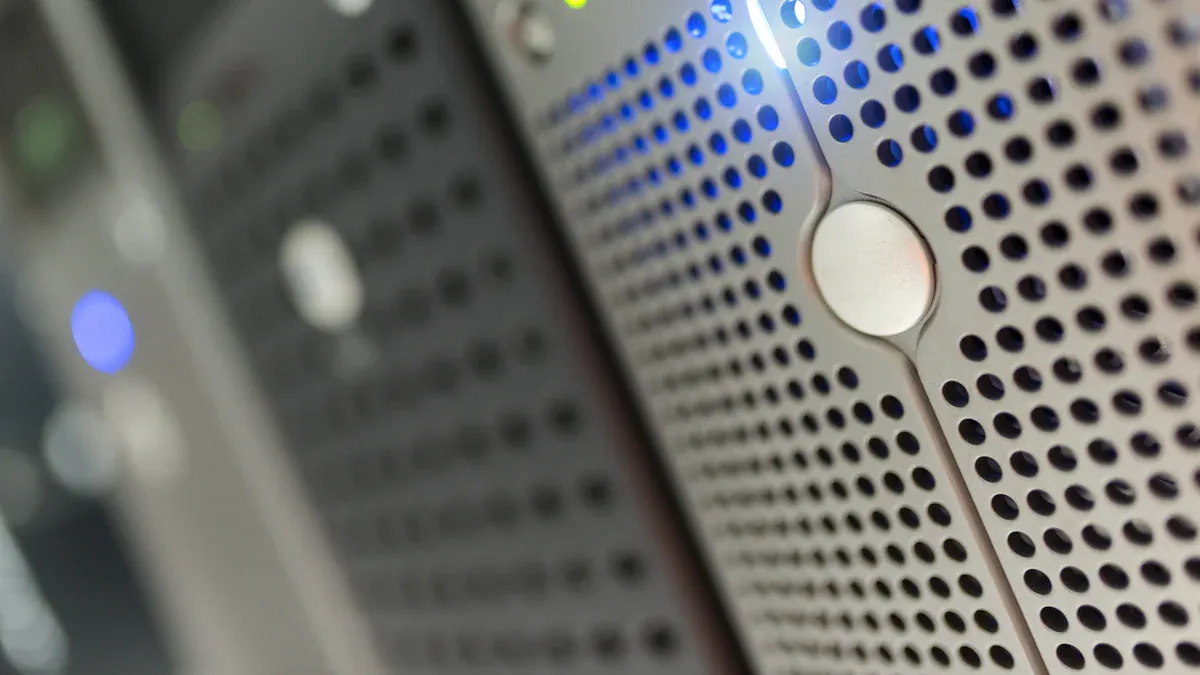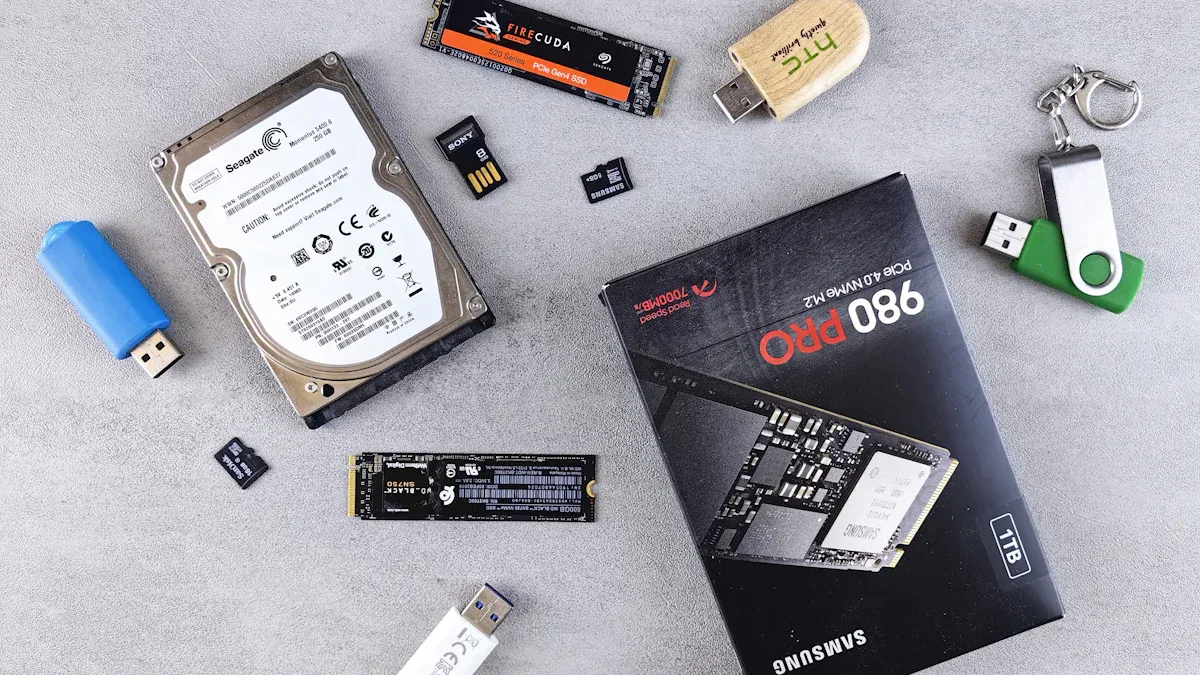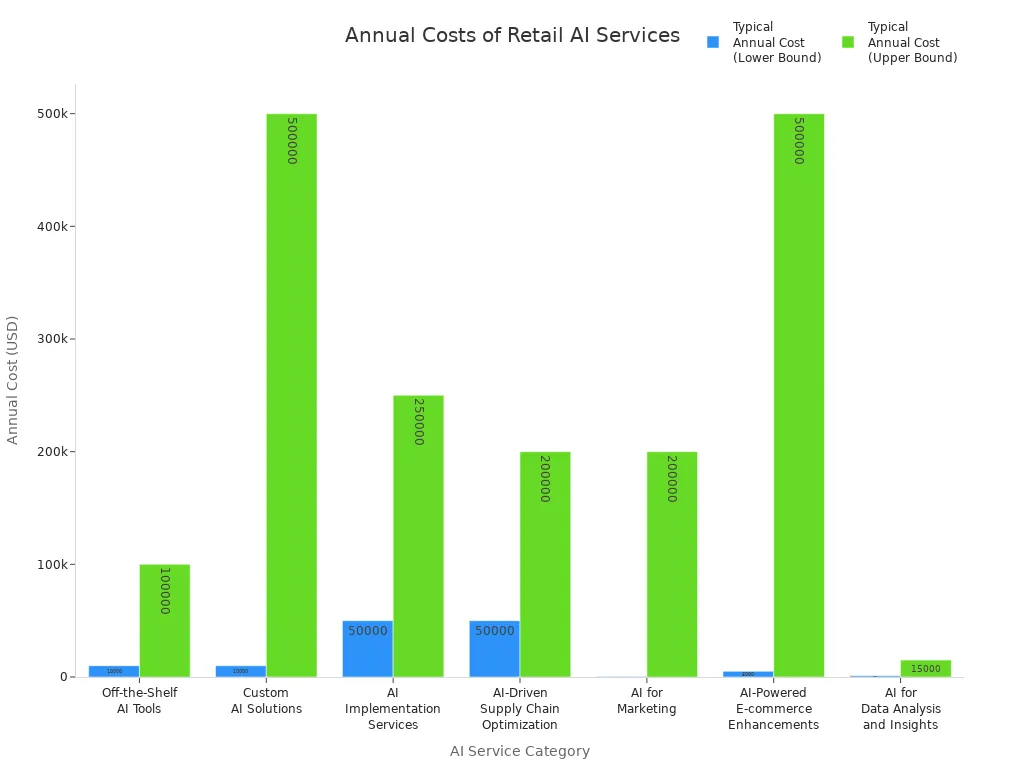How does the cost of AI edge devices compare to cloud solutions

You want to see if ai edge devices save more money than cloud solutions in your stores. The cost for each store is very important when you make choices for your business. Look at these numbers:
Solution Type | Cost Details | Annual Cost |
|---|---|---|
Cloud Solution | Streaming 4K video: about $300 per camera each month | |
Edge Solution | Edge servers: $5,000 for each store at the start | $600,000 to run them |
Retailers can save up to half on Total Cost of Ownership over three years by not paying for expensive data transfer and computer power. Edge AI also gives you answers in less than 100 milliseconds, so your store works faster.
Key Takeaways
AI edge devices cost more at first, but they save money later. This is helpful for businesses with lots of stores.
Cloud solutions cost less to start, but they can get expensive over time. This happens because of data transfer and usage fees.
Edge devices process data nearby, so they give faster answers. They also help keep data private and use the cloud less.
Think about what your business needs. You should look at how private your data is and how fast you need answers. This helps you pick edge or cloud solutions.
You can use both edge and cloud together. This gives you more choices and uses the best parts of each.
AI Edge Devices: Costs

Upfront Investment
When you look at ai edge devices, the first thing you notice is the upfront cost. You pay for the hardware, installation, and sometimes custom software. Here’s what you might expect:
A typical server for ai edge devices can cost over $10,000.
If you want a backup system, add another $2,000 or more.
Some custom AI services can push your investment from $10,000 up to $500,000, depending on what you need.
If you use third-party software, you might pay nothing or up to $40,000 each year.
The number of stores you have changes the total cost. More stores mean more devices, but sometimes you get a better price per device when you buy in bulk. If your store already has some of the needed equipment, you might save money.
Ongoing Expenses
After you set up ai edge devices, you still have to pay for maintenance and support. On average, stores spend between $25,000 and $100,000 each year to keep these systems running. Sometimes, costs go up if you need updates or extra security. For example, one company found that updates and support for their AI system cost $300,000 a year, which surprised them.
Tip: By processing data right in your store, you spend less on internet and cloud storage. This can save you a lot over time.
Scalability
As your business grows, you want your costs to make sense. Ai edge devices help you save money as you add more stores. When you process data locally, you don’t need to send as much information to the cloud. This means you pay less for bandwidth and storage. You also get faster answers, which helps your store run better.
Here’s a quick look at how local processing helps:
Key Component | Benefit |
|---|---|
On-device data storage | |
Local processing | Real-time answers, less cloud use |
Efficient data sync | Updates devices without heavy internet use |
Ai edge devices can help you control costs as you grow, especially if you want fast results and less reliance on the cloud.
Cloud Solutions: Costs

Data Transmission
When you use cloud AI, you send a lot of data to the cloud. This can get expensive very quickly. You pay for every gigabyte you send. The price changes depending on where your data goes. For example:
If you send European customer data to the U.S., it might cost $0.09 for each gigabyte.
Data egress and usage fees are different for each cloud provider. They also change based on storage class and how often you use your data.
If you have many stores or use high-quality video, costs go up fast. Moving data out of the cloud or between regions can be costly. These charges can surprise you. You need to check these fees often so you do not spend too much.
Storage and Compute
Cloud providers have different ways to pay for storage and computer power. Here is a quick look:
Pricing Model | Description |
|---|---|
Pay-As-You-Go (PAYG) | You pay only for what you use. This is good if your needs change a lot. |
Reserved Instance | You get discounts if you promise to use resources for 1 or 3 years. |
Savings Plans | You agree to spend a certain amount for lower rates. You can use different services. |
Sustained-Use Discounts | You get automatic discounts after using services for a while. |
Spot Instances | You use extra capacity at a lower price, but it can be taken away at any time. |
Subscription-Based Pricing | You pay every month or year for some services or software. |
AI tasks need much more power than normal jobs. For example, natural language processing can use 100GB of data and 10 GFLOPS every hour. Computer vision tasks need even more power. If you add more stores, your storage and compute costs can rise fast. Many companies see their cloud bills almost double in two years. This is mostly because of AI.
Subscription Fees
Cloud AI services often charge subscription fees. These can be simple monthly payments or big yearly contracts. Here is a sample of what you might see:
Category | Cost Range | Best For |
|---|---|---|
Off-the-Shelf AI Tools | $50–$300/month, $10k–$100k/year | Small to medium retailers |
Custom AI Solutions | $50k–$500k+ (development), 15–20% annual maintenance | Large retailers |
AI Implementation Services | $1k–$50k/month, $50k–$250k setup | End-to-end support |
AI for Marketing | $500–$5k/month, $50k–$200k/year | Boosting engagement |
AI for Data Analysis | $1k–$15k/year, $10k–$100k setup | Actionable insights |

Be careful about hidden costs. Some vendors show low prices each month but add fees for usage, model access, or extra features. You also need to think about compliance and security. Cloud AI systems need regular checks to keep your data safe and make sure your business follows the rules.
Cost Comparison
Summary Table
Here is a table that compares costs for 200 stores. It shows the main differences between ai edge devices and cloud solutions:
Feature | AI Edge Devices | Cloud Solutions |
|---|---|---|
Upfront Cost | $5,000 per store ($1,000,000 total) | $0 (no hardware needed) |
Ongoing Cost (Annual) | $250 per store/month ($600,000/year) | $300 per camera/month ($1.92M/year) |
Data Transfer Fees | Low (local processing) | High (constant uploads) |
Maintenance | Local IT or managed service | Included in subscription |
Scalability | Add devices as you grow | Pay for more usage and storage |
Real-Time Analytics | Yes (milliseconds) | Possible, but often slower |
Privacy Control | High (data stays on site) | Lower (data sent to cloud) |
You spend more money at first for ai edge devices. But you save money every year after that. Cloud solutions seem cheaper at first. But the costs can get high over time, especially if you have many stores or use video.
The total cost changes as time goes on. If you use AI for many years, ai edge devices usually cost less. Cloud solutions let you change things easily. But you might get surprise bills for sending data or using extra services.
Use Case Examples
You may wonder which choice is best for your store. Here are some examples to help you pick:
Use Case | Best Solution | Why It Works Well |
|---|---|---|
Smart Checkout | AI Edge Devices | Fast, local processing for smooth customer experience |
Inventory Tracking | AI Edge Devices | Real-time updates, less cloud traffic |
Personalized Recommendations | AI Edge Devices | Instant suggestions based on in-store behavior |
Seasonal Promotions | Cloud Solutions | Quick to scale up or down for short-term needs |
Centralized Analytics | Cloud Solutions | Easy to gather data from many locations |
Ai edge devices are best when you need fast answers, want to keep data private, or want lower internet costs. Local processing means you do not send all your data to the cloud. This saves money and helps your store run quickly.
Cloud solutions are good if you want to try new things, need to grow fast, or want to manage everything from one place. But remember, costs can go up if you use more data or add stores.
Did you know? Spending on edge computing is growing quickly. Experts think global spending will reach $380 billion by 2028. That is almost 14% growth each year. Many stores use ai edge devices to help customers. This now makes up over a quarter of all computer vision AI spending in stores.
You have a choice to make. If you want to save money over time and need fast, private results, ai edge devices are a smart choice. If you want more flexibility and do not mind higher costs, cloud solutions may be better for you.
Choosing the Right Approach
Business Needs
You want to pick the best AI solution for your stores. Start by looking at what your business really needs. Here’s a simple table to help you compare:
Criteria | What to Think About |
|---|---|
Data Sensitivity | Do you handle private or sensitive data? |
Latency Requirements | Do you need answers right away, or can you wait a few seconds? |
Infrastructure Readiness | Do you have the right setup for edge, cloud, or both? |
Connectivity | Will your stores always have strong internet, or do you need offline options? |
Scalability Needs | Are you starting small, or do you plan to grow to many stores? |
If you work with private customer data, edge devices help you keep information safe. They process data right in your store, so less data travels over the internet. This lowers the risk of data leaks and helps you follow rules like GDPR or CCPA. Edge AI also gives you fast answers, which is great for things like smart checkout or real-time alerts.
Cloud solutions work well if you want to collect lots of data from many places. They make it easy to run big reports and spot trends. If your stores have good internet and you want to scale up quickly, cloud AI can help.
Tip: Many businesses use both edge and cloud together. This hybrid approach gives you the speed and privacy of edge, plus the power and flexibility of the cloud.
Long-Term Impact
Think about costs now and in the future. Edge devices cost more at the start because you buy hardware and set it up. But you save money over time, especially if you use lots of data or need fast results. You also pay less for sending data since most of it stays local.
Cloud AI lets you pay as you go. This sounds easy, but costs can rise fast as you add more stores or use high-quality video. Sending lots of data to the cloud can get expensive, sometimes costing more than the AI itself.
If you plan to grow, ask yourself:
Do you need instant decisions and strong privacy? Edge AI is a smart pick.
Do you want to handle huge amounts of data and run big analytics? Cloud AI fits best.
Want the best of both? A hybrid model can save money and boost performance as you grow.
Choosing the right mix now helps your business stay flexible and cost-effective for years to come.
You save more over time with AI edge devices if you need fast answers, strong privacy, and lower data costs. Cloud solutions work best when you want easy scaling and centralized data. Before you choose, look at this cost table:
Solution | Upfront Costs | Ongoing Costs |
|---|---|---|
Edge AI | Higher hardware investment | Lower data transfer fees |
Cloud AI | No hardware needed | Recurring usage fees |
Want to make the right call? Try these steps:
Check if your store needs instant results or can wait.
Review your current tech setup and data flow.
Set clear goals for your AI project.
Measure results and adjust as you grow.
Think about both the starting price and what you’ll pay each month. Scalability matters, so plan for the future as you decide.
FAQ
What is the biggest cost difference between edge and cloud AI?
You pay more upfront for edge devices. Cloud AI has lower starting costs but higher monthly fees. Over time, edge devices usually save you money, especially if you have many stores.
Can I use both edge and cloud AI together?
Yes, you can! Many stores use a hybrid approach. You get fast answers from edge devices and big-picture insights from the cloud. This mix gives you flexibility and better performance.
How do edge devices help with privacy?
Edge devices process data right in your store. Your sensitive information stays local. You send less data to the cloud, which lowers the risk of leaks and helps you follow privacy rules.
Will my costs go up if I add more stores?
If you use cloud AI, your costs rise quickly as you add stores. Edge devices cost more at first, but you control ongoing expenses better as you grow.
Do I need special IT staff for edge devices?
You might need some local IT help for setup and maintenance. Many companies offer managed services, so you do not have to hire a big team.
See Also
A Detailed Look At Amazon Go Versus Cloudpick
Understanding The Growth Of AI-Driven Convenience Stores
The Future Is Here: Embracing AI-Enabled Retail Stores
Transforming Online Retail Management With AI-Driven Tools
Exploring The Advantages Of AI-Enhanced Combo Vending Machines
